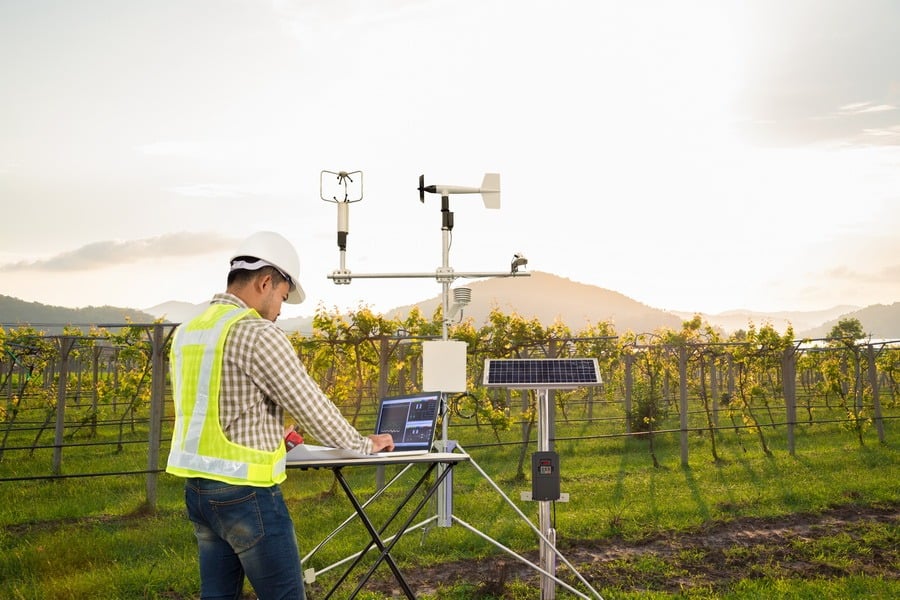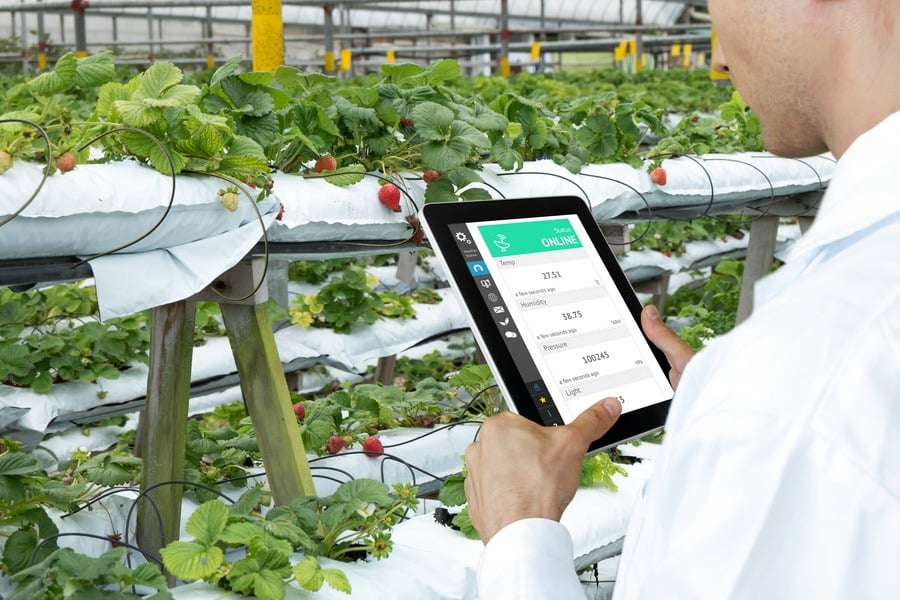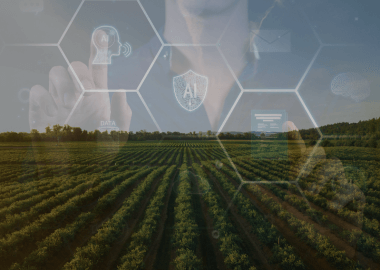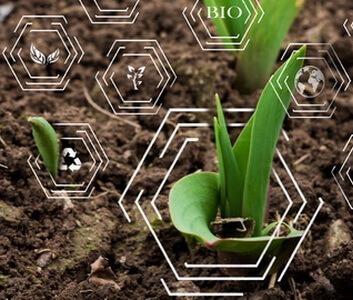6 Benefits and Use Cases of Big Data for Modern Agriculture
According to a Markets and Markets forecast, the global agriculture analytics market is expected to grow from $1.4 billion in 2023 to $2.5 billion by 2028. Most companies are racing to catch up with this trend and invest in big data, so we’ve collected everything you need to know about this topic.
With the agriculture industry facing challenges like feeding the growing population, the need for sustainability, and global inflation, big data might just be the solution we all seek.
Now we’ll uncover the benefits, challenges, and specific use cases of big data in agriculture. You will learn about the technologies involved (such as AI and IoT) and whether it is a good fit for your business to invest in them.

In the context of agriculture, big data is the collection and analysis of a large volume of data. It usually comes from various sources: sensors (placed in the soil), drones, satellites, etc. This also means that the data is usually in different formats (heatmaps, images, diagrams, etc.), which provides a challenge when combining them to draw a conclusion.
When it comes to big data services in agriculture, there are various technologies involved. Artificial Intelligence (AI), Machine Learning (ML), the Internet of Things (IoT), and robotics are all connected to big data, and they are all used to collect and analyze data and implement solutions based on it.
AI is especially rising in the agriculture sector — just like in every other industry. According to a recent market report, the global AI In Agriculture market worth is expected to grow from $1.5 billion in 2023 to around $10.2 billion by 2032.
Of course, companies face several issues related to harvesting big data, but this practice has many more advantages.
Let’s cover the benefits of big data in agriculture first.

In general, the application of big data in agriculture drives innovation, eliminates guesswork by supporting data-driven decisions with insights, and helps you remain competitive.
Let’s see the specifics of how you can achieve all of this.
1. Reduce costs and grow your revenue
The number one question on decision-makers’ minds is whether such a hefty investment would be profitable.
And the answer is YES. Big time.
Big data allows farmers and agribusinesses to access accurate forecasts for planning and harvesting. Climate change is impacting the weather to extremes. Droughts, floods, and volatile temperatures sometimes cannot be predicted with traditional methods.
However, the new technologies can empower you to take preventive measures to protect your crops against the elements and minimize loss.
By placing sensors in the soil, you can monitor nutrient levels, humidity, and other factors. This way, you can ensure crop health and optimize its growth by adding fertilizers or water when needed. This also leads to minimizing loss and maximizing yield.
Real-time data monitoring can also show other issues, such as an infestation, and help you to act fast and apply the right amount of pesticide to maximize the effect while protecting the environment.
2. Cut waste and opt for sustainability
The agriculture industry is pushed towards sustainability both by the customers and government regulations. Precision agriculture is growing steadily, and with it, the need to reduce waste and improve efficiency.
Using big data analysis in agriculture is one of the best weapons against our current wasteful practices. By analyzing the soil, we can avoid under- or over-watering and reducing water waste. Applying too much fertilizers can also harm the environment.
Food waste is also a huge issue that can be minimized by optimizing the entire process from production to distribution. For example, big data can also help with supply chain issues leading to food waste.
According to the organization Feeding America, $444 billion worth of food is wasted annually in the US. One of the leading causes is farmers leaving unharvested crops in the fields due to low prices or overproduction.
But another culprit is the problems that occur during food transportation and manufacturing. Both of these causes can be dealt with by using data to drive sustainable, modern agricultural solutions.
3. Improve productivity and safety
The role of big data in agriculture is to monitor not only the livestock and crops but also the equipment and infrastructure. Data can show in advance if maintenance is due or if faulty farm equipment needs to be replaced.
This can help you to optimize efficiency and save money, but also to provide a safe environment for your employees and avoid accidents. Data-powered technologies can even calculate fuel consumption, which can be very useful when fuel prices fluctuate.
4. Automate to reduce human error
The use of IoT, sensors, and other technologies provides great opportunities to automate processes and set up remote control. For example, automating the lighting and temperature in a storage or a greenhouse can lead to better results.
Automation not only helps to avoid human mistakes but also frees your employees from recurring tasks, allowing them to focus their time and effort on solving more complex problems.
On-farm data can also be transferred to mobile phones or other personal devices, so that you can monitor everything in real-time, remotely.
Transform your data into growth!
Gain a competitive advantage with custom-built big data and AgTech solutions.
DISCOVER OUR EXPERT SERVICES
When we described the benefits, we already showed how big data is used in agriculture in general.
But to be more specific, we’ve also collected a few real-life examples.
Forecasts about global agriculture trends, food security, and climate change
If we look at the list of the most innovative AgTech companies, one name stands out: Gro Intelligence.
Their climate risk navigator tool provides weather and climate data globally. This application is unique because it connects 20 years of historical data to projections extending to 2100!
Users can compare crop growing conditions in different countries and make data-proven investments.
Smart pest control with real-time data
Trapview’s focus is on something smaller but with an equally big impact. Insects can create huge problems and financial losses for farmers and agribusinesses.
Thanks to their monitoring and forecasting solutions, companies can protect their crops and minimize the environmental impact.
This is a fine example of the application of big data analytics in agriculture: they are combining AI and cloud technology to maximize their insights.

One of the biggest challenges companies face when using big data analytics in agriculture is that they manage to acquire the data, but they lack the expertise to gain valuable insights from it.
Think about it this way. Knowing the soil’s moisture level will not help you unless you take the next step to implement a solution based on this information.
Not making good use of your data can lead to massive financial loss. Setting up a big data infrastructure is expensive, so turning this data into a competitive advantage should be your top priority.
To help you better understand the intricacies of big data and agriculture, here’s a brief list of the big data challenges you might face on your journey toward data-driven farming.
- Unmanageable volume. Collecting too much data can lead to several problems, including a lack of proper storage space and a slow time to insight. Basically, the data can already be outdated by the time it gets analyzed and interpreted.
- Unstructured data. If your data comes from multiple sources (as is the case for most agribusinesses), it is probably in different formats. Then, you need to create a format that your big data visualization tools can use to give you the insights you need.
- Incorrect data. Errors, such as duplicate, missing, or outdated data, can lead to incorrect insights and bad business decisions.
- Data privacy and security concerns. In addition to following local data protection regulations, you must implement strong security measures for your own good. Data science can lead to world-first innovations and provide a competitive edge that others are eager to get their hands on.
Of course, solutions do exist for all of these problems, but we will not go into the details here.
What you need most is a reliable tech partner with custom agriculture software development services.
A partner who can guide you through all these challenges and help you get the most out of your data.
We have extensive experience in providing custom software development and big data services for companies in the agriculture industry.
We’ve worked together with well-known organizations such as Premier Tech and Origin Digital. To prove our expertise in providing big data development services, let us show you two case studies.
Developing smart farming tools for Origin Digital
Origin Digital is famous for transforming geospatial intelligence into innovative insights for farmers. They promote sustainable precision farming solutions to boost performance and profitability.
In order to scale up, they needed to add experienced engineers to their projects. We helped them augment their tech team fast so that they could improve their products and grow their impact.

Custom data processing app for an agriculture analytics company
Our client was struggling with paperwork and data storage. They needed a custom document management system to automate the processing of different PDF invoices and other documents.
The goal was to extract information, such as the invoice number, date, and company name, and then send the data to an AWS cloud service to store it safely.
We analyzed their business process and built a PDF processing platform with smart text recognition and extraction based on computer vision technology, cloud computing, and Deep Learning methods.
Our solution allowed them to organize their data at scale so it can grow along with their business.
Turn your data into actionable insights
Big data can be a powerful tool when done right. Secure your company’s future with our help!
HIRE BIG DATA EXPERTSConclusion
Big data can lead to great business opportunities if used well – but navigating the different technologies and trends can be confusing.
That’s why we’ve collected the main benefits and challenges of big data in agriculture in this article. If you have any further questions, please don’t hesitate to contact us. As a custom big data and software development company, we’re here to solve all your specific problems.







